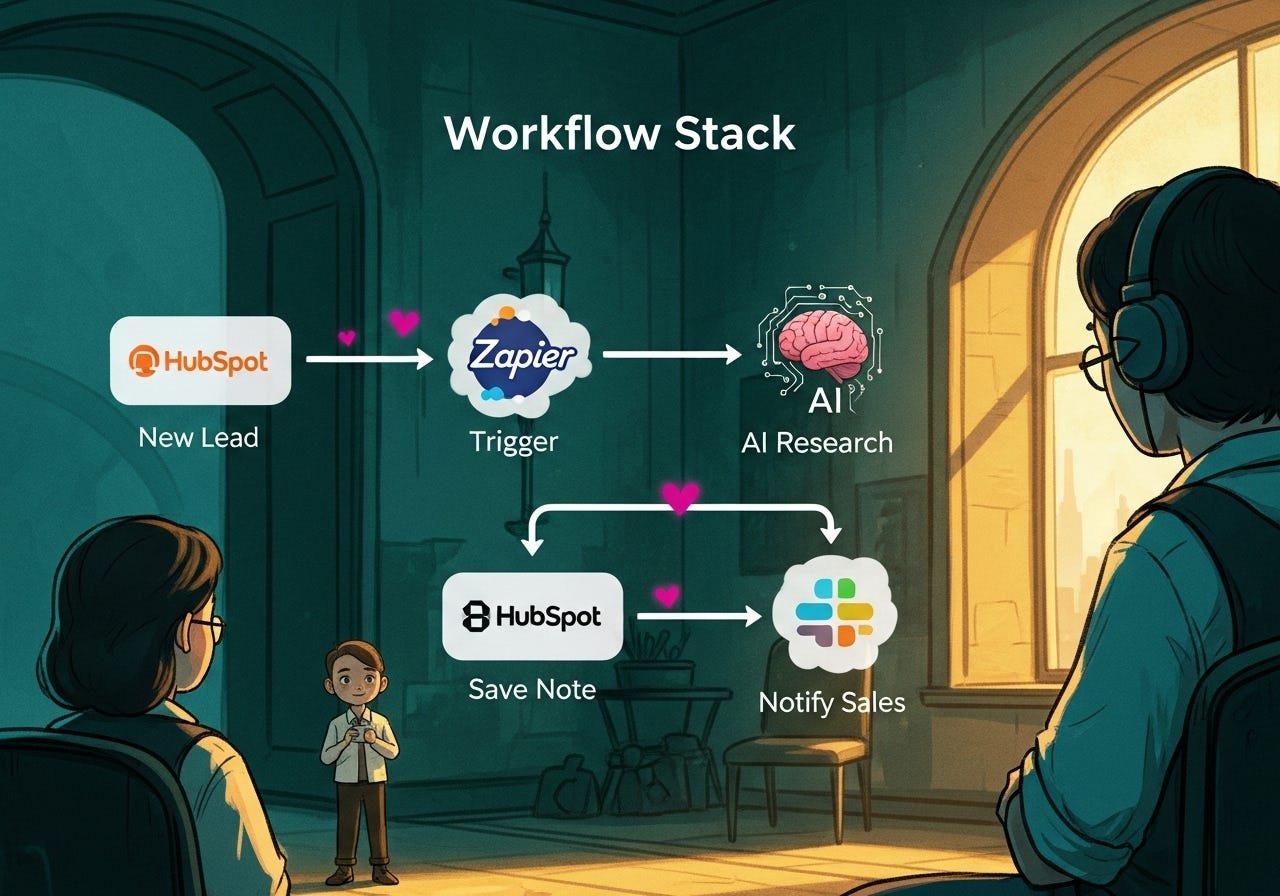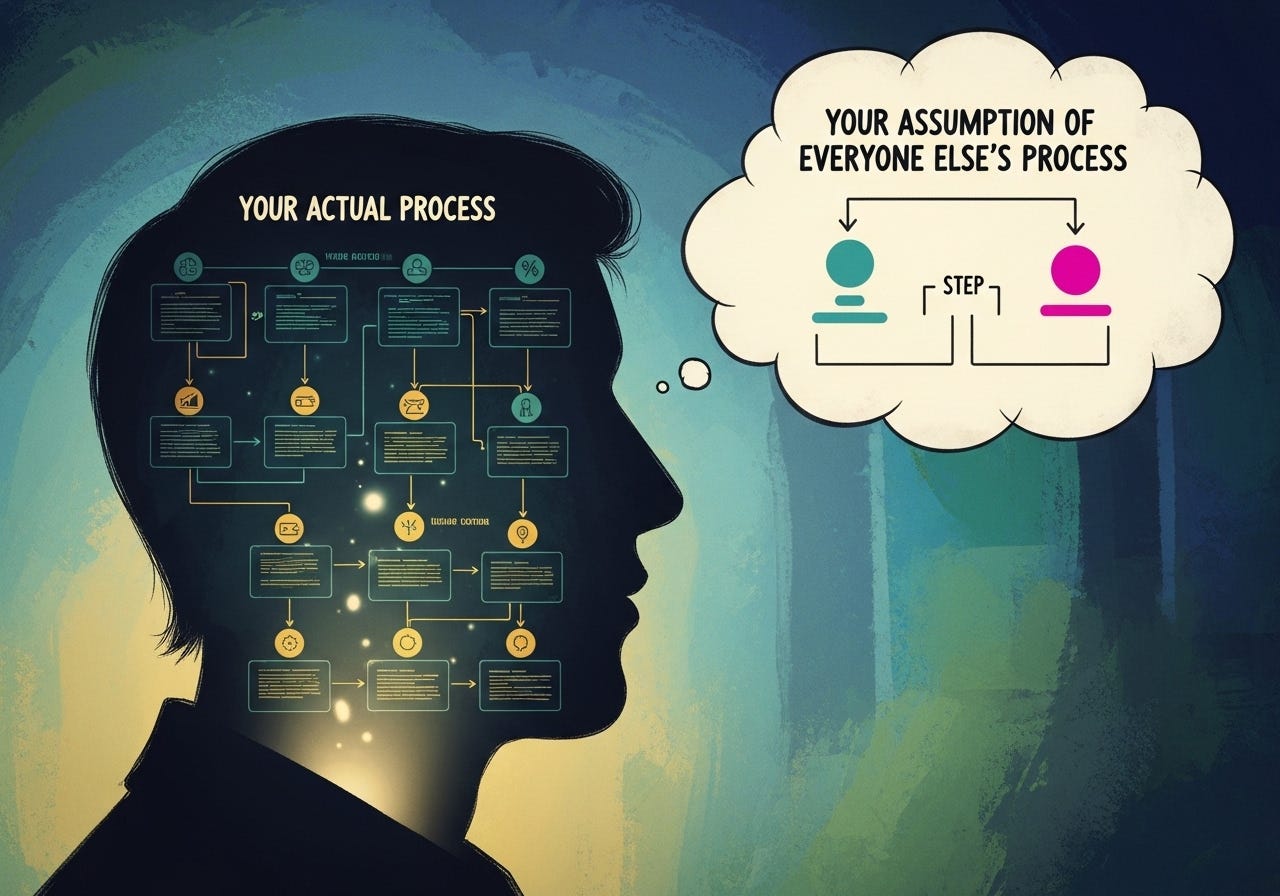To go fast with AI, first go slow
What the physical limits of my record collection taught me about building a real AI strategy.
Welcome to today’s edition of ROBOTS ATE MY HOMEWORK. Today we’re going to talk about the most common disease plaguing founders in the age of AI.
I have a six-foot-wide record shelf. It’s custom-built from solid oak, and it’s nearing capacity.
Every new record I bring home is a physical negotiation. I have to find a precise spot for it, feel its weight, and slide it into place among the others. The sheer physical presence and finite space force me to be a ruthless, deliberate curator.
A year ago, I realized my digital life had no such limits. My browser bookmarks bar was a weightless, infinite junk drawer of forgotten AI tools. My credit card was attached to a dozen subscriptions I barely used. The lack of physical friction had turned me from a curator into a hoarder.
I decided to ignore the hype and go incredibly deep on one, single system for my own startup, Yahini. That system became our "Customer-to-Content Flywheel," and mastering it had a bigger impact on our growth than a decade of dabbling.
To go fast, we first had to go very, very slow.
Here’s what you’ll get out of this piece:
A four-step audit to find the one AI workflow that actually drives your business.
Why your “obvious” system is actually a secret weapon (and how to use it).
A powerful prompt to turn your undocumented process into a scalable engine.
🤖 ROBOT REPORT CARD
We are suffering from AI FOMO. It’s a frantic energy, a desperate scramble to try every new tool, every "5 prompts to 10x your life" listicle.
The result, for me, was a pile of shallow automations that saved me minutes but cost me hours in context switching. I was getting a lot of motion, but zero forward momentum.
Your unique advantage will come from deeply integrating one or two powerful, repeatable workflows into the core of your business.
This is the exact audit I ran on myself. I hope it helps you too.
Step 1: List your "AI tasks"
First, you have to get honest about the gap between what you could be doing and what’s actually hurting your business.
Open a document and create two columns.
In the first column, list your “AI possibilities.”
This is the brain dump. Get it all down. What are all the things you see people doing with AI that make you a little bit jealous? Your list might look something like mine did:
Writing first-draft social media content
Summarizing long customer interview transcripts
Brainstorming unique marketing angles
Automating prospect research before a sales call
Analyzing competitor product reviews for weaknesses
Creating weird AI art for internal jokes
Now, in the second column, list your “Business bottlenecks.”
This is the more important part. Where is your business leaking time, money, or quality right now? Where does work get stuck?
Sales team spends too much time on pre-call research.
Takes forever to turn customer feedback into actionable product ideas.
Our content marketing feels generic and isn't generating leads.
Onboarding new hires to our marketing process is a mess.
Now, draw lines. Connect the possibilities in the first column to the pain in the second. This simple act moves you from playing with AI to solving business problems with AI.
Step 2: Find the "Keystone Habit"
You should now have a few promising workflows - tasks that connect a cool AI capability to a real business bottleneck. But which one do you focus on?
“Follow your gut” is terrible advice. We need a system.
You’re going to score your top 3-5 candidates using a simple matrix. For each potential workflow, score it from 1-5 across three factors:
Leverage (downstream impact): How many other business activities does this workflow feed or improve? (1 = very few, 5 = it impacts almost everything).
Frequency (repeatability): How often will you run this system? (1 = a few times a year, 5 = daily or weekly).
Value (closeness to revenue): How directly does this impact a core business goal like revenue, lead generation, or customer retention? (1 = very indirectly, 5 = a straight line to the goal).
Let’s say one of your candidates is “Automating Prospect Research.”
Leverage: It supercharges the sales team's effectiveness (feeds sales calls), provides insights for marketing campaigns (feeds marketing), and might even identify product gaps (feeds product). Score: 4
Frequency: Your sales team does this for every single qualified lead. It's a daily activity. Score: 5
Value: Better-prepared salespeople close more deals. It’s a very direct line to revenue. Score: 5
Total Keystone Score: 14
Do this for your top contenders. The highest score isn't a magic answer, but it’s your strongest signal. It's the workflow you should pour your energy into mastering first.
Step 3: Go all-in
Now comes the part everyone wants to skip. For the next 30 days, you will go on a distraction diet. Your only goal is to turn this one process into a masterpiece.
A. Build your "Workflow Stack." Document the specific tools you will use at each stage. Your goal is a seamless flow of information. It might look like this:
Input: A new lead in HubSpot.
Action: Triggers a Zapier automation.
Research: Zapier sends the prospect's domain to an AI agent tasked with the research.
Output: The finished analysis is saved as a note in the HubSpot record.
Notification: A message is posted in the #sales Slack channel.
B. Create your "Prompt Playbook." This is your most valuable asset. Create a library for every single prompt in your workflow. For each one, document:
The goal: A one-sentence description of the desired output.
The persona: E.g., “You are a world-class enterprise sales strategist.”
The context: All the background information the AI needs, including pasted data or context from previous steps.
The prompt: The exact, version-controlled prompt text.
A golden output: A perfect example of what the output should look like. This is your benchmark for quality.
C. Define your success metric. You have to define the win in concrete terms, or you’ll never know if you've won.
Bad metric: Save time for the sales team.
Good metric: Reduce average pre-call research time from 45 minutes to 5 minutes.
Step 4: Teach the system
The final test is to create a "Workflow One-Pager". This is a single document so clear that a new hire could run the entire process flawlessly on their first day.
Your one-pager must include:
Objective: A single sentence explaining what this process achieves.
Owner: The person responsible for ensuring it runs smoothly.
The stack: The list of required tools, with links.
The playbook: A link to your master Prompt Playbook.
The checklist: A numbered, step-by-step process that a human follows. Each step should be brutally simple. E.g., "1. Copy transcript from Otter.ai. 2. Paste transcript into Prompt #1 in the Playbook. 3. Copy the output and paste it into a new Slack message in the #customer-insights channel."
Congrats, you've taken a valuable process that lived inside your head and turned it into a scalable, repeatable, and improvable engine.
💡 A NEW CONCEPT FOR YOU
We have a glitch in the human brain that’s particularly dangerous for founders and it's called the False Consensus Effect.
The formal definition is our tendency to believe that our own opinions, beliefs, and behaviors are way more common in others than they actually are.
In simple terms: we think everyone sees the world the way we do. And it's a blind spot that can absolutely kill your momentum.
Here’s how it bites you after you’ve done the hard work.
Once you build and master a keystone workflow, that system feels deeply, fundamentally logical to you. Your brain, a vicious pattern-matcher, immediately makes a dangerous assumption:
'This is so effective, surely everyone else is doing this.'
You start to believe your hard-won secret weapon is just standard operating procedure.
This either makes you paranoid, thinking you’re somehow still behind, or it makes you complacent, robbing you of your unique advantage. Worse, it cripples your marketing.
You assume customers and competitors see the problem through the same lens you do.
The strategic move is to consciously invert this. You have to recognize that your deep, integrated system is valuable precisely because it is not the consensus. That feeling of “obviousness” you have is the very definition of an unfair advantage.
What feels like common sense to you is breakthrough strategy to everyone else.
(You can read the original 1977 paper that coined the term, but this article from Simply Psychology is a fantastic and more accessible breakdown of the concept.)
✨ ONE MORE THING...
I'm not going to lie to you. The hardest part of this entire process for me, the part I wanted to skip every single time, was writing it all down. Staring at a blank page feels like the exact opposite of getting sh*t done. This is super tedious, but it matters a lot.
You can't scale a thought. You can scale a well-documented process.
So when you’re staring at that blinking cursor thinking “where the hell do I even start?” use your AI as a sparring partner. Use it to break the inertia. Here’s the prompt I come back to when I feel stuck:
I am a founder of a [your business type].
My potential AI use cases are [list your 3-5 top use cases from Step 1].
Act as a skeptical but brilliant business coach. Tell me which ONE of these tasks is the 'keystone workflow' - the one that, if mastered, will provide the most leverage and positive impact on the others.
Justify your choice with a logical argument based on downstream effects and pressure test my assumptions.In the spirit of the record collection: what's your “desert island” app? One boring, reliable, battle-tested tool you absolutely could not live without.
Let me know!
To staying out of the noise,
Chief 🤖 at ROBOTS ATE MY HOMEWORK









These are some great tips, Mia, especially for beginners.
(PS: The other day, I just saw the cosy library image when you shared the link, only now getting to read the article)
I think your system, or at least your approach works for any use of AI in multi-compartment projects, and that kind of involves "life" itself. I really enjoyed your article and subscribed to your substack.